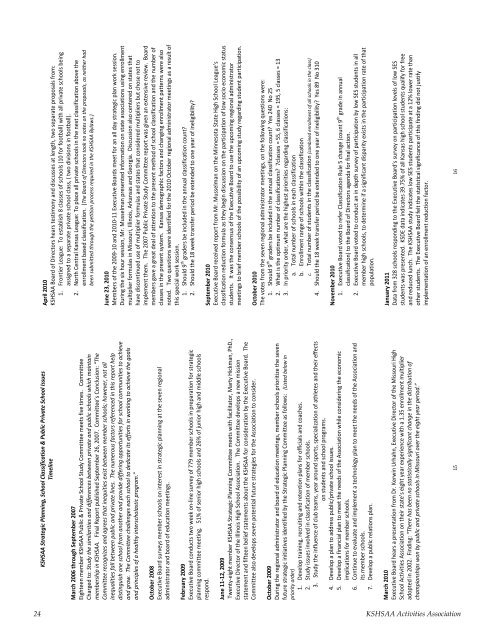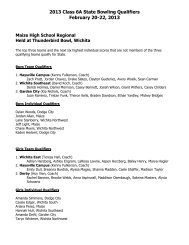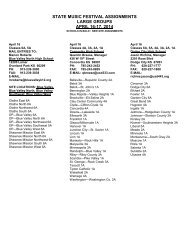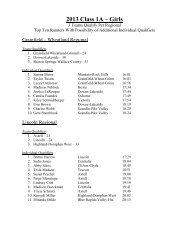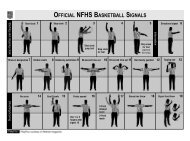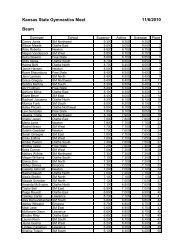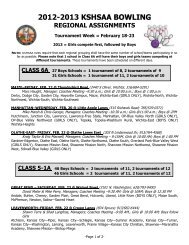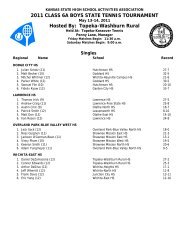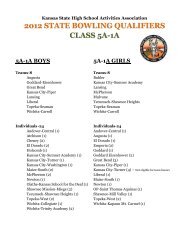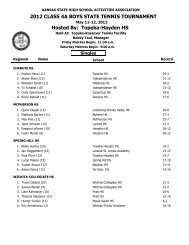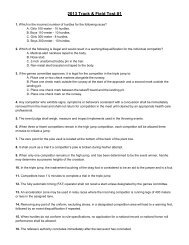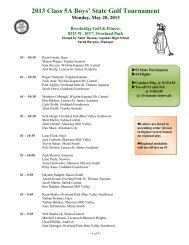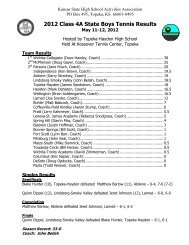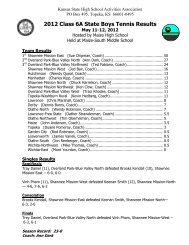K A N S A S S T A T E H I G H S C H O O L JANUARY 2012 - kshsaa
K A N S A S S T A T E H I G H S C H O O L JANUARY 2012 - kshsaa
K A N S A S S T A T E H I G H S C H O O L JANUARY 2012 - kshsaa
You also want an ePaper? Increase the reach of your titles
YUMPU automatically turns print PDFs into web optimized ePapers that Google loves.
April 2010<br />
KSHSAA Board of Directors hears testimony and discusses at length, two separate proposals from:<br />
1. Frontier League: To establish 8 classes of schools (10 for football) with all private schools being<br />
assigned to a separate private school class, ( two divisions in football).<br />
2. North Central Kansas League: To place all private schools in the next classification above the<br />
enrollment based classification. (The Board of Directors took no votes on the proposals, as neither had<br />
been submitted through the petition process required in the KSHSAA Bylaws.)<br />
KSHSAA Strategic Planning, School Classification & Public Private School Issues<br />
Timeline<br />
June 23, 2010<br />
Members of the 2009-10 and 2010-11 Executive Boards meet for an all day strategic plan work session.<br />
During the six hour session, Mr. Musselman presented information on state associations using enrollment<br />
multiplier formulas in Missouri, Illinois, Arkansas and Georgia. Discussion also centered on states that<br />
have discontinued use of multiplier formulas and states that considered multipliers but chose not to<br />
implement them. The 2007 Public Private Study Committee report was given an extensive review. Board<br />
members gave a great deal of attention to the present method of school classification and the number of<br />
classes in the present system. Kansas demographic factors and changing enrollment patterns were also<br />
noted. Two questions were identified for the 2010 October regional administrator meetings as a result of<br />
this special work session.<br />
1. Should 9 th graders be included in the annual classification count?<br />
2. Should the 18 week transfer period be extended to one year of ineligibility?<br />
March 2006 through September 2007<br />
Eighteen member KSHSAA Public & Private School Study Committee meets five times. Committee<br />
Charged to: Study the similarities and differences between private and public schools which maintain<br />
membership in KSHSAA. Final Report published September 26, 2007. Committee’s Conclusion: “The<br />
Committee recognizes and agrees that inequities exist between member schools; however, not all<br />
inequalities fall between public and private lines. The numerous factors referenced in this report help<br />
distinguish one school from another and provide differing opportunities for school communities to achieve<br />
and grow. The Committee challenges each school to dedicate its efforts in working to achieve the goals<br />
and principles of a healthy interscholastic program.”<br />
October 2008<br />
Executive Board surveys member schools on interest in strategic planning at the seven regional<br />
administrator and board of education meetings.<br />
February 2009<br />
Executive Board conducts two week on-line survey of 779 member schools in preparation for strategic<br />
planning committee meeting. 51% of senior high schools and 26% of junior high and middle schools<br />
respond.<br />
September 2010<br />
Executive Board received report from Mr. Musselman on the Minnesota State High School League’s<br />
classification reduction formula as they begin discussion on the participation of low socio economic status<br />
students. It was the consensus of the Executive Board to use the upcoming regional administrator<br />
meetings to brief member schools of the possibility of an upcoming study regarding student participation.<br />
June 11-12, 2009<br />
Twenty-eight member KSHSAA Strategic Planning Committee meets with facilitator, Marty Hickman, PhD.,<br />
Executive Director of the Illinois High School Association. The Committee develops a new mission<br />
statement and fifteen belief statements about the KSHSAA for consideration by the Executive Board. The<br />
Committee also develops seven potential future strategies for the Association to consider.<br />
October 2010<br />
The votes from the seven regional administrator meetings, on the following questions were:<br />
1. Should 9 th graders be included in the annual classification count? Yes 240 No 25<br />
2. What is the optimum number of classifications? 7classes = 55, 6 classes = 195, 5 classes = 13<br />
3. In priority order, what are the highest priorities regarding classifications:<br />
a. Total number of schools in each classification<br />
b. Enrollment range of schools within the classification<br />
c. Total number of students in the classification (combined enrollment of all schools in the class)<br />
4. Should the 18 week transfer period be extended to one year of ineligibility? Yes 89 No 310<br />
November 2010<br />
1. Executive Board voted to refer Classification Rule 5 change (count 9 th grade in annual<br />
classification) to the Board of Directors agenda for final action.<br />
2. Executive Board voted to conduct an in depth survey of participation by low SES students in all<br />
member high schools, to determine if a significant disparity exists in the participation rate of that<br />
population.<br />
October 2009<br />
During the regional administrator and board of education meetings, member schools prioritize the seven<br />
future strategic initiatives identified by the Strategic Planning Committee as follows: (Listed below in<br />
priority order)<br />
1. Develop training, recruiting and retention plans for officials and coaches.<br />
2. Study issues involved in classification of member schools.<br />
3. Study the influence of club teams, year around sports, specialization of athletes and their effects<br />
on students and school programs.<br />
4. Develop a plan to address public/private school issues.<br />
5. Develop a financial plan to meet the needs of the Association while considering the economic<br />
implications for member schools.<br />
6. Continue to evaluate and implement a technology plan to meet the needs of the Association and<br />
its member schools.<br />
7. Develop a public relations plan.<br />
January 2011<br />
Data from 328 schools responding to the Executive Board’s survey on participation levels of low SES<br />
students was presented. KSDE data indicates 39.75% of all Kansas high school students qualify for free<br />
and reduced lunch. The KSHSAA study indicates low SES students participate at a 12% lower rate than<br />
other students. The Executive Board felt the statistical significance of this finding did not justify<br />
implementation of an enrollment reduction factor.<br />
March 2010<br />
Executive Board hears a presentation from Dr. Kerwin Urhahn, Executive Director of the Missouri High<br />
School Activities Association on their state’s eight year experience with a 1.35 enrollment multiplier<br />
adopted in 2002. Finding: “There has been no statistically significant change in the distribution of<br />
championships won by public and private schools in Missouri over the eight year period.”<br />
24 KSHSAA Activities Association<br />
16<br />
15


